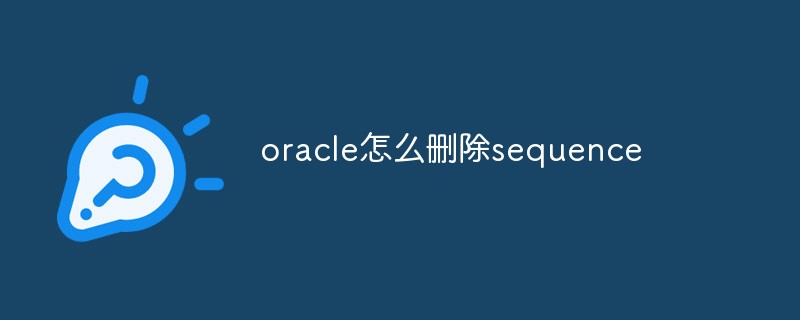 Database
Database Oracle
Oracle Summarize and organize knowledge points on creating users and table spaces in Oracle
Summarize and organize knowledge points on creating users and table spaces in OracleThis article brings you relevant knowledge about Oracle. The Oracle database is commonly used in JAVAEE projects. As a background program developer, you can master how to create users and table spaces in Oracle. It is an essential skill. The following introduces the relevant information about creating users and table spaces in Oracle. I hope it will be helpful to everyone.

Recommended tutorial: "Oracle Video Tutorial"
Oracle-Create User
View table space
select tablespace_name, file_id, file_name, round(bytes/(1024*1024),0) total_space_MB from dba_data_files order by tablespace_name;
Oracle Create table space
create tablespace 表空间名字 --空间名 datafile '数据存储路径\***.dbf' --路径 size 5M --初始大小 autoextend on next 5M --表空间每次增长大小 maxsize 3000M --表空间最大内存
Oracle Modify table space size
alter database datafile 'E:\DATA\ORACLE\.DBF' resize 20480m
—Create user
create user "****" identified by xyx2021 default tablespace "****";
—User authorization
grant connect, resource to "***"; grant create session to "***";
—Modify user BEE table space
Alter user BEE default tablespace BEE
-Delete table space
drop tablespace fish;
Summary
Oracle installation completed Finally, there is a default database. In addition to this default database, we can also create our own database.
In order to avoid trouble, you can use the 'Database Configuration Assistant' wizard to create the database (this step must be created, because if it is not done well here, an error will occur when creating the table space - I spent a few days here. hours, dizzy).
After creating the database, you cannot create a table in the database immediately. You must first create a user for the database and specify a table space for the user.
The following is the specific process of creating a database user:
1. If the name has been created now It is the database of 'test'. At this time, the test directory already exists in the d:\oracle\oradata\ directory (Note: My Oracle11g is installed under d:\oracle. If your Oracle is installed in another directory, Then your newly created database directory will be under the *\oradata\ directory).
#2. Before creating a user, you must first create a table space:
The format is: Format: create tablespace inter-table name datafile 'data file name' size table space size;
For example: SQL> create tablespace test_tablespace datafile 'd:\oracle\oradata\test\test.dbf' size 100M;
Where 'test_tablespace' is the name of your customized table space, you can name it arbitrarily;
'd:\oracle\oradata\test\test.dbf' is the storage location of the data file, 'test. The dbf' file name is also arbitrary;
'size 100M' specifies the size of the data file, which is the size of the table space.
Delete namespace
DROP TABLESPACE test INCLUDING CONTENTS AND DATAFILES CASCADE CONSTRAINTS;
3. Now create a file named 'test_tablespace ' tablespace, the user can be created as follows:
The format is: Format: create user username identified by password default tablespace tablespace table;
For example: SQL> create user testone identified by testone default tablespace test_tablespace;
The default tablespace 'default tablespace' uses the tablespace created above.
4. Then authorize the newly created user:
Oracle Video Tutorial"
The above is the detailed content of Summarize and organize knowledge points on creating users and table spaces in Oracle. For more information, please follow other related articles on the PHP Chinese website!
 什么是oracle asmApr 18, 2022 pm 04:16 PM
什么是oracle asmApr 18, 2022 pm 04:16 PMoracle asm指的是“自动存储管理”,是一种卷管理器,可自动管理磁盘组并提供有效的数据冗余功能;它是做为单独的Oracle实例实施和部署。asm的优势:1、配置简单、可最大化推动数据库合并的存储资源利用;2、支持BIGFILE文件等。
 oracle怎么查询所有索引May 13, 2022 pm 05:23 PM
oracle怎么查询所有索引May 13, 2022 pm 05:23 PM方法:1、利用“select*from user_indexes where table_name=表名”语句查询表中索引;2、利用“select*from all_indexes where table_name=表名”语句查询所有索引。
 oracle全角怎么转半角May 13, 2022 pm 03:21 PM
oracle全角怎么转半角May 13, 2022 pm 03:21 PM在oracle中,可以利用“TO_SINGLE_BYTE(String)”将全角转换为半角;“TO_SINGLE_BYTE”函数可以将参数中所有多字节字符都替换为等价的单字节字符,只有当数据库字符集同时包含多字节和单字节字符的时候有效。
 Oracle怎么查询端口号May 13, 2022 am 10:10 AM
Oracle怎么查询端口号May 13, 2022 am 10:10 AM在Oracle中,可利用lsnrctl命令查询端口号,该命令是Oracle的监听命令;在启动、关闭或重启oracle监听器之前可使用该命令检查oracle监听器的状态,语法为“lsnrctl status”,结果PORT后的内容就是端口号。
 oracle怎么删除sequenceMay 13, 2022 pm 03:35 PM
oracle怎么删除sequenceMay 13, 2022 pm 03:35 PM在oracle中,可以利用“drop sequence sequence名”来删除sequence;sequence是自动增加数字序列的意思,也就是序列号,序列号自动增加不能重置,因此需要利用drop sequence语句来删除序列。
 oracle查询怎么不区分大小写May 10, 2022 pm 05:45 PM
oracle查询怎么不区分大小写May 10, 2022 pm 05:45 PM方法:1、利用“LOWER(字段值)”将字段转为小写,或者利用“UPPER(字段值)”将字段转为大写;2、利用“REGEXP_LIKE(字符串,正则表达式,'i')”,当参数设置为“i”时,说明进行匹配不区分大小写。
 oracle怎么查询数据类型May 13, 2022 pm 04:19 PM
oracle怎么查询数据类型May 13, 2022 pm 04:19 PM在oracle中,可以利用“select ... From all_tab_columns where table_name=upper('表名') AND owner=upper('数据库登录用户名');”语句查询数据库表的数据类型。
 Oracle怎么修改sessionMay 13, 2022 pm 05:06 PM
Oracle怎么修改sessionMay 13, 2022 pm 05:06 PM方法:1、利用“alter system set sessions=修改后的数值 scope=spfile”语句修改session参数;2、修改参数之后利用“shutdown immediate – startup”语句重启服务器即可生效。


Hot AI Tools

Undresser.AI Undress
AI-powered app for creating realistic nude photos

AI Clothes Remover
Online AI tool for removing clothes from photos.

Undress AI Tool
Undress images for free

Clothoff.io
AI clothes remover

AI Hentai Generator
Generate AI Hentai for free.

Hot Article

Hot Tools

Dreamweaver CS6
Visual web development tools

ZendStudio 13.5.1 Mac
Powerful PHP integrated development environment

Atom editor mac version download
The most popular open source editor

SublimeText3 Mac version
God-level code editing software (SublimeText3)

Safe Exam Browser
Safe Exam Browser is a secure browser environment for taking online exams securely. This software turns any computer into a secure workstation. It controls access to any utility and prevents students from using unauthorized resources.





